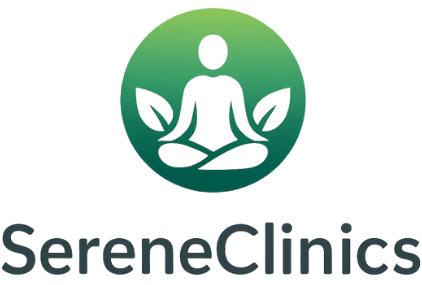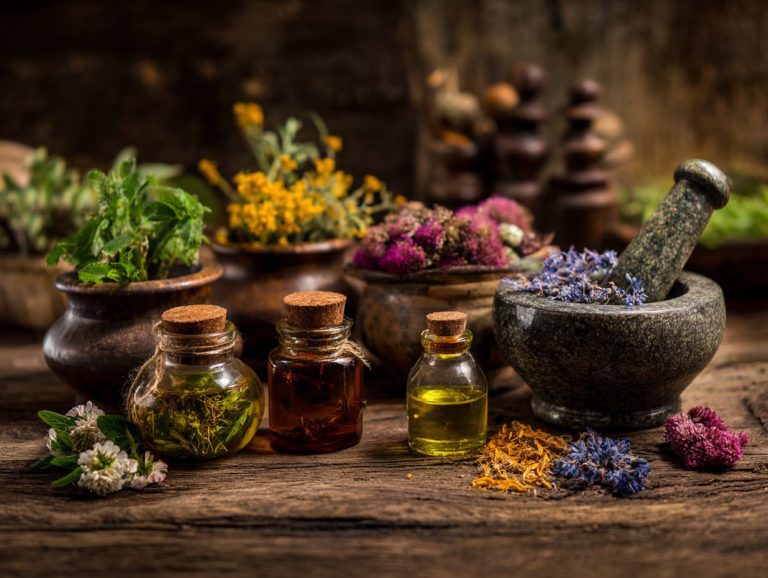Herbal Medicine and Modern Science: Bridging Tradition
Herbal medicine has stood the test of time, offering natural products that have been foundational in traditional medicine. With scientific advancements, such as the development of artemisinin from sweet wormwood, modern medicine is increasingly recognizing the value of these ancient practices. This article examines how clinical trials and research link herbal remedies with modern health treatments, illustrating the potential advantages of using these methods together for upcoming healthcare.
Key Takeaways:
Contents
- 1 Traditional Uses of Herbal Medicine
- 2 Herbal Medicine Usage Statistics
- 3 Modern Scientific Approaches
- 4 Bridging Tradition and Science
- 5 Challenges and Limitations
- 6 Future Directions
- 7 Appendix
- 8 Frequently Asked Questions
- 8.1 1. What is herbal medicine and how does it relate to modern science?
- 8.2 2. How does herbal medicine differ from modern pharmaceuticals?
- 8.3 3. Is there scientific evidence to support the use of herbal medicine?
- 8.4 4. Can herbal medicine be used in conjunction with modern medical treatments?
- 8.5 5. Are there any risks or side effects associated with herbal medicine?
- 8.6 6. Can anyone use herbal medicine, or are there certain precautions to take?
Definition and Scope

Herbal medicine is defined as the practice of using plant-derived substances for healing, encompassing a wide range of treatments and applications across various healthcare systems.
This practice includes different methods like tinctures, which are herbal extracts made by soaking herbs in alcohol; teas, which are mild remedies made by brewing dried plants in water; and extracts, strong forms created through unique processes.
Herbal medicine can stop illnesses from happening, like using echinacea to strengthen the immune system, and can also address conditions, such as using ginger for stomach problems. For context, a guide from Mount Sinai explores these practices extensively, offering valuable insights into their uses and benefits.
Knowing your particular health aims can help you decide which of these different types to choose. Interested in how broader holistic health practices can complement herbal medicine? Explore holistic health to find a comprehensive approach to wellness.
Historical Context
The historical roots of herbal medicine date back thousands of years, with ancient healers across cultures documenting their empirical knowledge of medicinal plants.
The ‘Shennong Ben Cao Jing’, written around 200 AD, lists many herbs and their uses in Chinese medicine, demonstrating the organized methods of early doctors.
Ayurveda, with writings such as the ‘Charaka Samhita’ from 600 BC, focuses on overall health and balancing body functions, combining daily habits and nutrition with plant-based treatments.
In Africa, traditional medicine typically focuses on local plants, with healers applying knowledge shared verbally through generations. This shows the worldwide importance and usefulness of herbal medicine in different cultures. As noted by the World Health Organization, traditional medicine has long contributed to modern healthcare, signaling its enduring relevance.
Traditional Uses of Herbal Medicine
Traditional herbal methods differ greatly worldwide, each providing distinct knowledge about using plants for health and well-being. For those interested in understanding these practices further, our beginner’s guide to using herbal medicine safely offers comprehensive insights.
Global Practices
In different cultures, herbal medicine is used in various ways, such as traditional Chinese medicine which looks at the body as a whole, and Ayurveda which emphasizes balance and harmony.
In Japan, Kampo uses certain herbs to treat different health problems. For instance, shiso (Perilla leaf) addresses respiratory issues, while ginseng enhances energy.
Meanwhile, Unani, rooted in Greek traditions, employs herbs like black seed (Nigella sativa) for immune support and coriander to aid digestion. Each system focuses on the herbs and the overall setting in which they are used, customizing treatments to fit each person’s needs and health issues.
Talking with experts or local herbalists is important for genuine use and knowledge in both practices.
Commonly Used Herbs
Certain herbs have gained prominence globally for their medicinal properties, including artemisinin for malaria and turmeric for inflammation.
Other notable herbs include:
- Ginger: Contains gingerol, known for its anti-nausea effects, commonly used in Asian cuisine and teas.
- Echinacea: Rich in flavonoids, it supports immune health, often found in herbal supplements and teas, especially during cold seasons.
- Garlic Allicin is found in garlic and helps maintain a healthy heart. It is commonly used in Mediterranean diets.
- Peppermint: Recognized for its menthol, it aids digestion and is prevalent in both culinary and medicinal teas.
Each of these herbs is used differently in various cultures, showing their different roles in both old and new recipes.
Herbal Medicine Usage Statistics
Herbal Medicine Usage Statistics
According to the Prevalence and associated factors of herbal medicine use study published in ScienceDirect, traditional medicine continues to play a significant role in modern healthcare systems. The World Health Organization (WHO) has emphasized the importance of integrating traditional practices with conventional medicine to enhance health outcomes globally.
Herbal Medicine Usage: Prevalence and Usage
Herbal Medicine Usage: Market and Sales
Herbal Medicine Usage: Health Benefits and Conditions
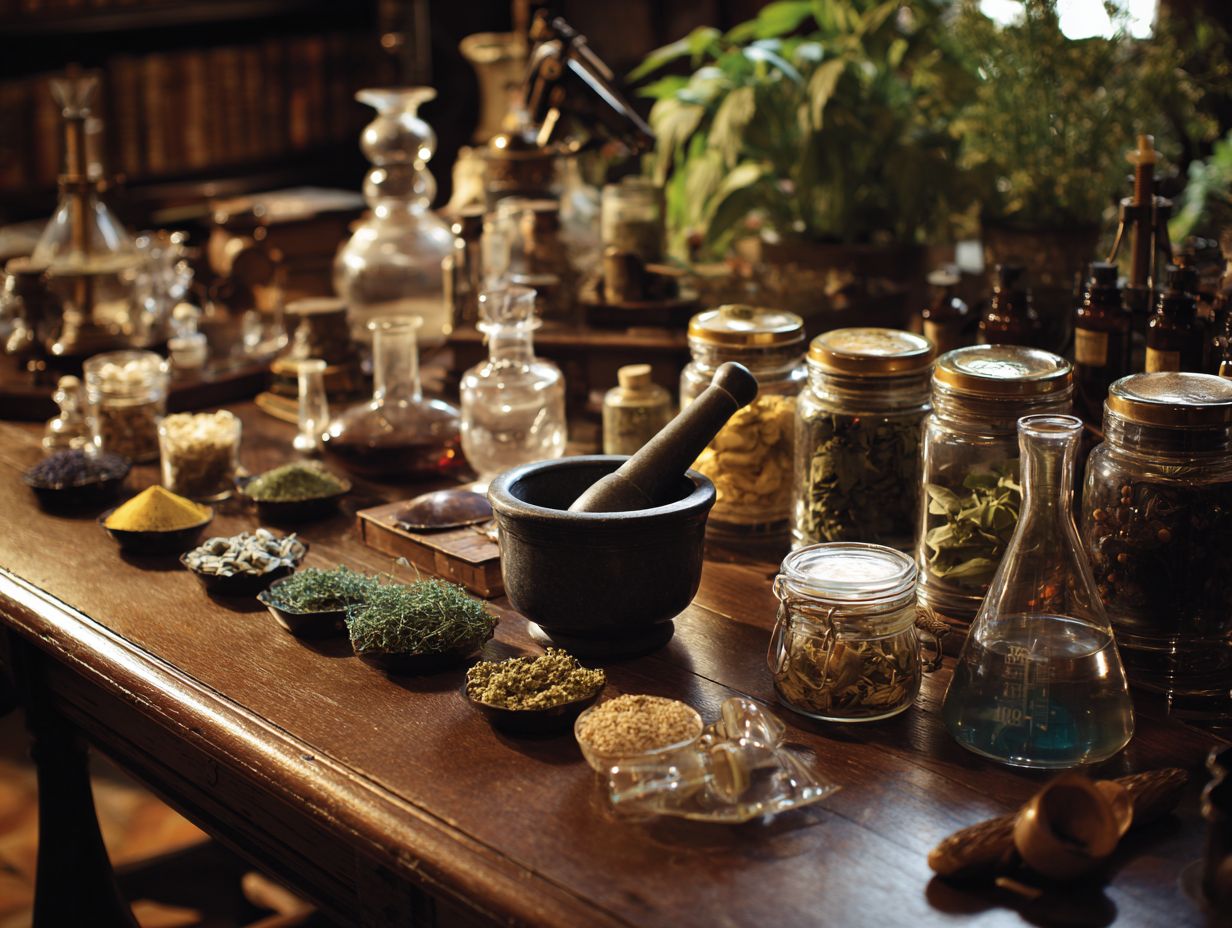
The data on Herbal Medicine Usage Statistics illustrates the widespread adoption and growing market of herbal medicines and supplements. This trend is evident across various demographics and regions, highlighting the importance of herbal medicine in both traditional and modern health practices.
Prevalence and Usage statistics show that in 2020, 42% of U.S. adults used herbal supplements, indicating a significant interest in natural remedies. Interestingly, 32.6% of Millennials and 40.2% of those born before 1946 also engage in using herbal medicine, revealing cross-generational appeal. Globally, 80% of the population relies on herbal medicine, emphasizing its critical role in global healthcare, especially where conventional medical resources are limited.
Market and Sales data points to substantial economic growth in the herbal supplements sector. The global market size is projected to reach $94.3 billion by 2032, reflecting increasing consumer demand. In 2020, the U.S. herbal supplements market was valued at $9.6 billion, showcasing strong domestic consumption. Additionally, China’s herbal medicine exports totaled $3.96 billion in 2020, underscoring its position as a leading producer and exporter.
Health Benefits and Conditions reveal that 80% of people in developing countries use herbal medicine, often as a primary healthcare source. Of herbal supplement users, 74% consume them to improve their immune system, while 65% of Millennials and Gen Z use herbal remedies, pointing to a health-conscious trend among younger populations. Additionally, 35.1% of herbal supplement users have chronic diseases, suggesting that these products are integrated into management strategies for long-term health conditions.
Overall, these statistics highlight the growing acceptance and reliance on herbal medicine across different demographics and regions, driven by perceived health benefits and cultural practices. The expanding market presents opportunities and challenges, particularly in ensuring the quality and efficacy of these natural products.
Modern Scientific Approaches
Modern science often supports traditional herbal practices by using strict clinical trials and research methods. If you’re interested in exploring the core concepts behind these practices, you might find our guide on Traditional Chinese Medicine: Principles, Practices, and Core Concepts to be insightful.
Research Methodologies
Researchers employ various methodologies to study herbal remedies, including randomized controlled trials and observational studies, to gather empirical evidence.
One notable example is the randomized controlled trial that examined echinacea’s effectiveness in preventing the common cold. In this study, participants consuming echinacea showed a 25% reduction in cold incidence compared to the placebo group. These findings highlight the need for thorough methods.
Observational studies often complement these trials by tracking large populations over time, revealing patterns in herbal usage and health outcomes. These diverse approaches together help healthcare practitioners make informed decisions about incorporating herbal treatments into patient care.
Clinical Trials and Efficacy
Clinical trials are important for checking how well herbal remedies work, with many now meeting strict scientific rules.
Recent studies show positive results for many herbal medicines. For instance, a 2021 trial involving ginseng revealed a 30% reduction in fatigue among participants compared to a placebo group.
Another noteworthy trial investigated turmeric, demonstrating significant anti-inflammatory effects in patients with arthritis, with 65% reporting pain relief. A meta-analysis of echinacea found improved immune response during cold seasons.
These results show that natural therapies are becoming more accepted in medical research. It is important for practitioners to stay up-to-date with current trials and their results.
Bridging Tradition and Science
Combining old herbal methods with current medical practices offers a complete way to care for patients, improving treatment results. For those new to this approach, learning to use herbal medicine safely is essential for maximizing its benefits.
Integrative Medicine
Integrative medicine emphasizes a cohesive approach, where herbal treatments complement conventional therapies, offering patients a broader range of options.
Many healthcare systems are embracing this philosophy. For example, the Duke Integrative Medicine program uses herbs like ashwagandha and turmeric with regular treatments for stress and inflammation.
The Memorial Sloan Kettering Cancer Center’s Integrative Medicine Service offers patients botanical therapy as part of managing symptoms from cancer treatments. These institutions collaborate with certified herbalists to develop care plans that are reliable and appropriate. They respect patient preferences while using established practices.
Case Studies of Successful Integration
Successful case studies highlight the effective integration of herbal medicine into clinical settings, demonstrating improved patient outcomes.
For instance, at the University of Maryland Medical Center, patients experiencing chronic pain were treated with turmeric and ginger supplements, resulting in a 30% reduction in pain levels over three months.
A study published in the Journal of Integrative Medicine revealed that patients with anxiety and depression reported significant improvements after a regimen that included St. John’s Wort, leading to a 50% decrease in symptoms.
These examples show how herbal remedies, such as turmeric for reducing inflammation and St. John’s Wort for improving mood, can work well alongside traditional medical approaches.
Challenges and Limitations
Although herbal medicine has advantages, there are problems and restrictions that need to be tackled for it to be more widely used and included in healthcare systems. To explore how different types of medicine can be regulated, you might consider learning about naturopathic practice regulations as they offer insights into state regulations and requirements.
Regulatory Issues
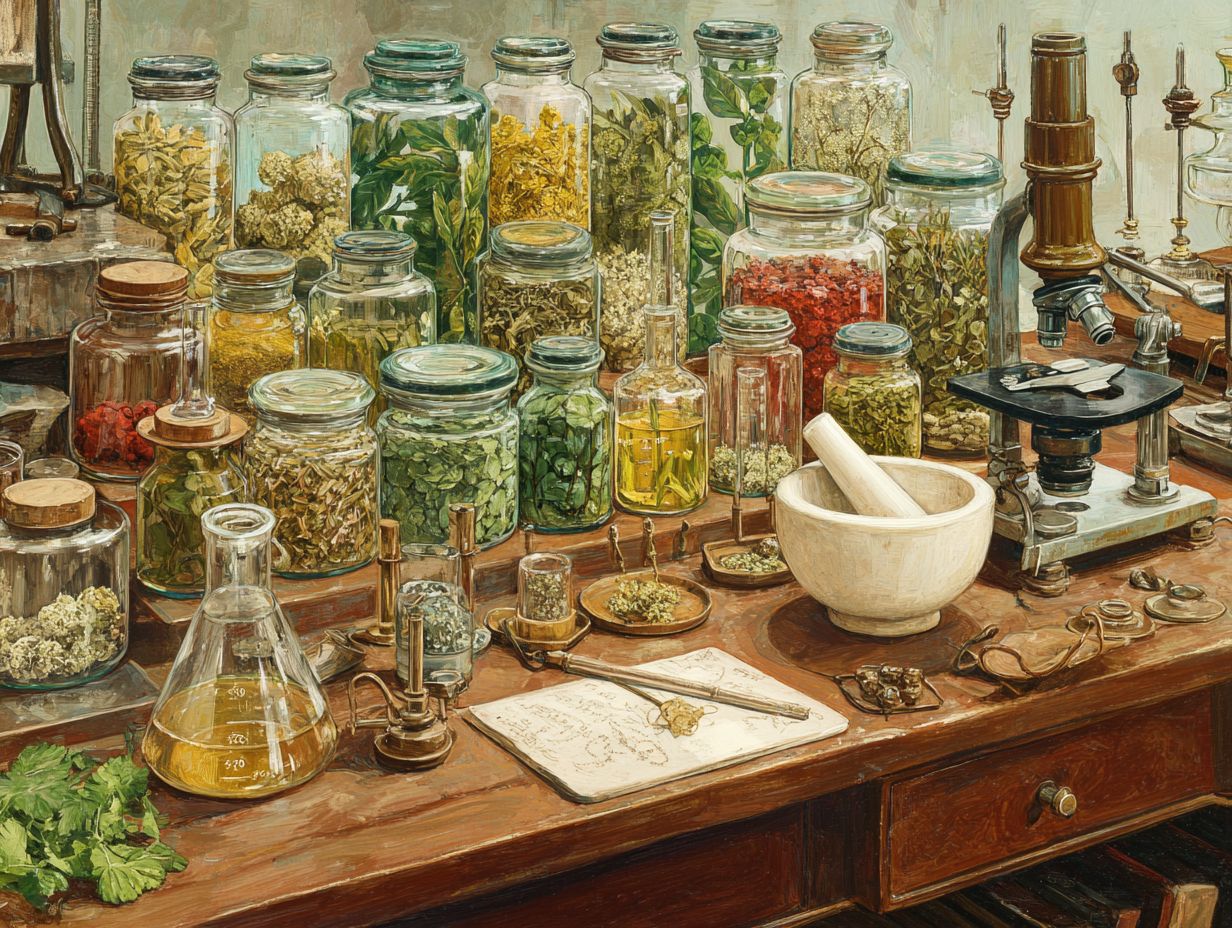
Regulatory issues surrounding herbal medicine often stem from a lack of standardized practices, impacting both safety and efficacy.
In countries like the United States, herbal products are regulated as dietary supplements, limiting research funded by the government. In Europe, the Traditional Herbal Medicinal Products Directive requires approval before products are sold, ensuring thorough safety checks but possibly limiting what’s available.
Meanwhile, organizations like the World Health Organization emphasize the need for quality control and efficacy verification to better integrate herbal medicine into global healthcare systems. This difference makes international trade and research harder, slowing progress in learning about the real benefits of herbal remedies.
Standardization of Herbal Products
The lack of standardization in herbal products can lead to variability in quality and efficacy, posing a significant challenge for practitioners and consumers.
To tackle this issue, companies such as Monterey Bay Herb Co. have put in place strict quality control measures. They employ methods such as lab testing for active ingredients and contaminants, ensuring each batch meets specified standards.
They follow Good Manufacturing Practices (GMP) to make production processes more efficient. Collaborative efforts among industry groups have also emerged, focusing on creating universally accepted guidelines.
When herbal companies join projects like the American Herbal Products Association’s (AHPA) efforts to set standards, they can build trust and make their products more dependable for customers.
Future Directions
Herbal medicine is developing with fresh ideas, especially as research progresses and treatment is customized for each person.
Innovations in Herbal Research
New research methods like nanotechnology and phytochemical analysis are improving our knowledge of medicinal plants and how to use them.
For instance, nanotechnology enables the encapsulation of herbal extracts, improving their bioavailability and effectiveness in drug formulations.
Studying plant chemicals using high-performance liquid chromatography (HPLC) helps precisely identify active substances. This helps to standardize herbal remedies and find new treatments.
By combining these methods, researchers can more effectively assess how herbs work together, opening up possibilities for customized medical treatments and specific therapies in the years to come.
Potential for Personalized Medicine
Personalized medicine opens new opportunities for herbal treatments, tailoring therapies to match each person’s genes and way of life.
Recent studies have shown that genetic variations in metabolizing enzymes, like CYP450, can significantly affect how patients respond to certain herbal supplements.
People with a certain genetic variant might feel stronger effects from St. John’s Wort, while others might have negative reactions.
Research from the University of California suggests genetic testing before using herbal treatments can improve effectiveness and safety.
Using this method alongside evaluations of a patient’s lifestyle, like what they eat and their physical activity, can make herbal treatments more suited to the individual, improving results and reducing dangers.
Summary of Key Points
This article highlighted the definition, traditional uses, scientific approaches, and challenges of herbal medicine, emphasizing its relevance today.
Combining traditional methods with modern scientific techniques can improve the usefulness of herbal medicine. For instance, performing clinical tests on herbs such as echinacea to assess their effect on the immune system can confirm traditional beliefs and help in proper use.
Using standardized extracts guarantees stable dosage and strength, dealing with safety worries. Practitioners could look into tools like databases for herbal interactions to reduce risks when used with medicines.
By combining past information with current studies, we can build a stronger system for using herbal medicine successfully.
Call to Action for Further Research
More studies on herbal medicine are needed to fully understand its benefits for today’s healthcare.
To support this effort, think about joining clinical trials that test how well certain herbs work. For instance, trials on turmeric for inflammation or ashwagandha for stress resilience are ongoing.
Advocate for research funding by connecting with organizations like the American Herbalists Guild or your local universities. Joining these groups can make your voice stronger and show why scientific proof is important in herbal treatments.
Using social media platforms to share information can bring together supporters and researchers in this important field.
Key Literature and Studies
Key literature includes studies on the medicinal properties of herbal remedies and their clinical trial results, providing a foundation for further research.
Seminal works in herbal medicine include “Herbal Medicine: Biomolecular and Clinical Aspects” by editors I. M. R. C. C. Bonifacio (2016), which compiles diverse studies on herbal efficacy.
An important paper is “The Efficacy of Herbal Medicines” by Chan et al. (2019), highlighting significant findings from clinical trials on echinacea and St. John’s Wort.
“The Role of Chinese Herbs in Hypertension” by Zhang and Wu (2020) looks into formulary methods, providing information about traditional treatments.
Such research underlines the importance of scientifically validating herbal treatments.
Online Resources and Databases
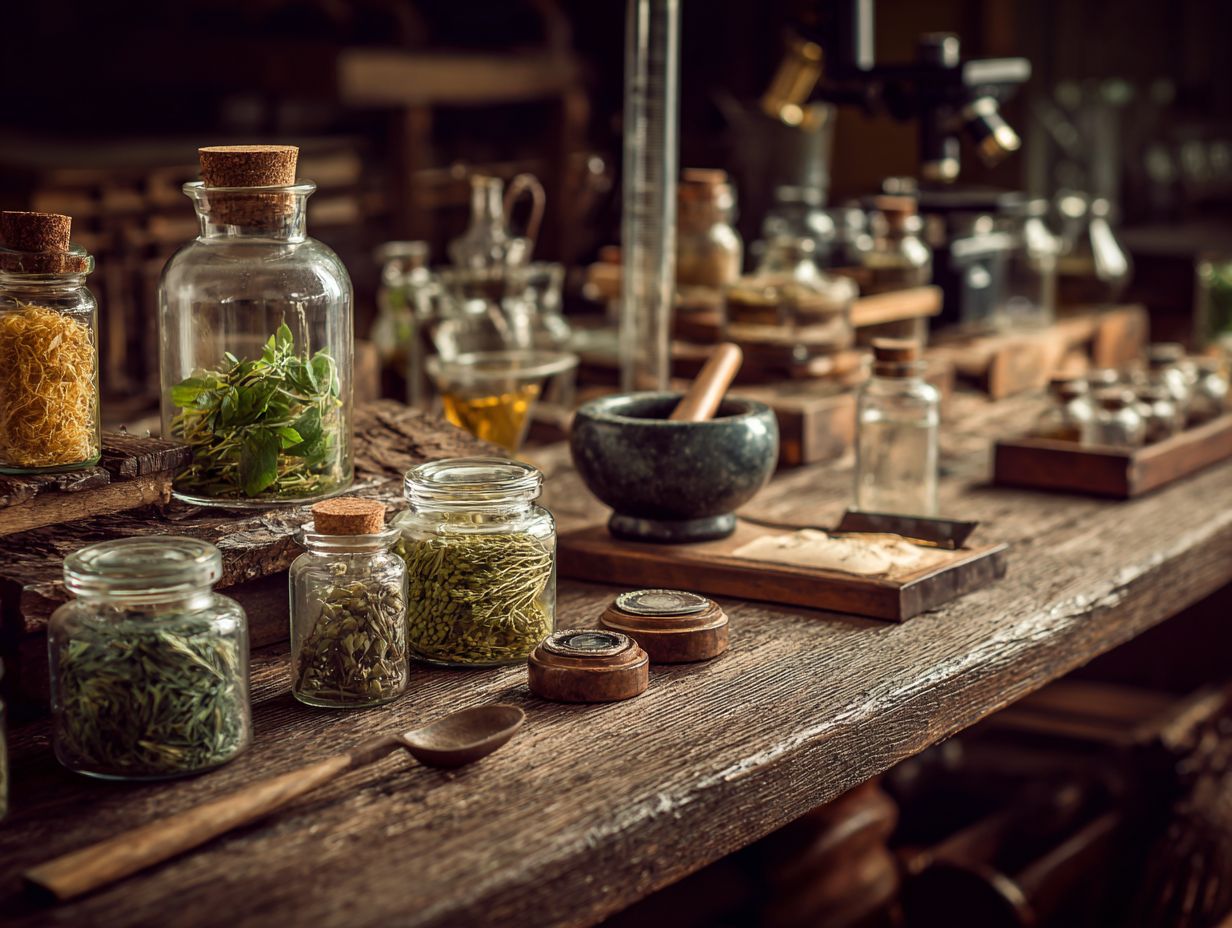
Many online resources and databases offer useful details about herbal medicine, such as research articles and results from clinical trials.
Prominent databases include PubMed for peer-reviewed articles and ClinicalTrials.gov for ongoing research studies.
The American Herbal Products Association (AHPA) offers a wealth of information specifically focused on herbal industry standards.
Platforms like HerbMed provide an extensive database of medicinal herbs, complete with research links and clinical evidence.
The National Center for Complementary and Integrative Health (NCCIH) provides trustworthy health information useful for practitioners and researchers.
Using these tools can improve how you learn and use herbal medicine.
Appendix
The appendix offers additional resources and information related to herbal practices and medicinal plants.
These resources contain detailed guides on the uses and dosages of different herbal remedies.
For instance, consider the utilization of echinacea for immune support, with a recommended dosage of 300-400 mg of standardized extract taken two to three times daily.
Peppermint can aid digestion; an infusion of 1-2 teaspoons of dried leaves in hot water can provide relief.
To use safely, always check with trustworthy sources or a healthcare professional, especially when mixing herbs with medications.
Frequently Asked Questions
1. What is herbal medicine and how does it relate to modern science?
Herbal medicine is a form of traditional medicine that uses natural plant-based remedies to treat various health conditions. Modern science has been researching and studying the effectiveness and safety of these herbal remedies, bridging the gap between traditional and modern approaches to healthcare.
2. How does herbal medicine differ from modern pharmaceuticals?
Herbal medicine uses natural ingredients from plants, while modern pharmaceuticals are often synthetic compounds created in a lab. Herbal medicine works on addressing the main cause of the problem, not just easing the symptoms.
3. Is there scientific evidence to support the use of herbal medicine?
Yes, modern science has done many studies on how well herbal medicine works for different health problems. Some herbal remedies have even been approved by government health agencies for their therapeutic benefits.
4. Can herbal medicine be used in conjunction with modern medical treatments?
Yes, in fact, many healthcare professionals now recommend the use of herbal medicine in conjunction with modern medical treatments. This can help improve overall health and well-being, and may also reduce the need for pharmaceuticals.
5. Are there any risks or side effects associated with herbal medicine?
As with any form of treatment, there is always a risk of potential side effects. However, when used properly and with the advice of a trained professional, herbal medicine is usually safe and well-tolerated.
6. Can anyone use herbal medicine, or are there certain precautions to take?
Herbal medicine is usually safe for most people, but you should talk to a qualified healthcare professional before beginning any herbal treatments. This is especially important if you have existing health issues or are on other medications.

Sheetal Sharda has a background in CS. She got an interest in Holistic living back in 2018, and has since started exploring more into Naturapathy, Holistic Living, Yoga, and more. She got inspired to start SereneClinics to help people find reliable centers across the world.
